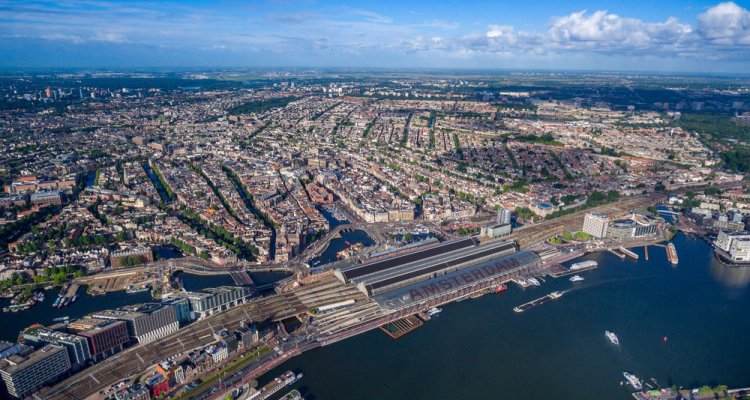
Project
Towards Water Smart Cities
Cities around the world face great challenges with water. We have to rethink the way we deal with water in our cities and need to (re)design cities from drained cities to green, resilient and circular cities, so called Water-Smart Cities.
Water is a vital resource and plays an important role for the liveability of cities. Cities around the world face great challenges with water including risks for water shortage and floods. These challenges ask for a systemic approach and a transition in urban planning and urban water management. We have to rethink the way we deal with water in our cities and need to (re)design cities from drained cities to green, resilient and circular cities, so called Water Smart Cities. A Water Smart City treats water as a resource instead of a nuisance. Every drop of water in our cities has a value. The transition towards Water Smart Cities is a huge opportunity to improve the quality of urban life.body text with sub titles. use photo’s (including an explanation) or video if possible.
Urbanization and climate change will have large impact on cities
The world is urbanizing. In 2050 over 6 billion people will live in cities. Cities around the world are confronted with many challenges, such as traffic congestion, inadequate energy supply, lack of basic services, informal dwellings, poor management of natural hazards, crime, environmental degradation, climate change, poor governance, urban poverty, informal economy and unplanned development (WEF, 2016). City densification is both, an opportunity for economic growth and a threat for liveability. Urban growth will put large pressure on the availability of water, food and energy. Climate change will put more pressure on cities by increasing the risk for floods, droughts and heat waves. The sense of urgency for climate mitigation and adaptation is growing.
Europe is one of the most urbanized continents in the world. More than two thirds of the European population lives in urban areas and this share continues to grow. Compared to urbanization rates in Asia and Africa, Europe is at a more steady state, and has the opportunity of showing good solutions for urbanized societies.
Water plays a central role in sustainable urban development
The World Economic Forum Global Risk Report identified failure of climate change mitigation and adaptation and the water crises – droughts and floods – as the risks with the largest expected global impact over the coming decades (WEF, 2016). Flood events are occurring more frequently causing major damage in urban areas. The frequency and intensity of rain events will increase in the future. Besides flood risk, water shortage is an increasing concern. A recent global study shows that 1 in 4 cities already is water stressed, and climate change and urbanization will increase the risk for water shortage in peri-urban river basins (McDonald et al., 2014). Water is essential for life. These challenges ask for a systemic approach and a transition in urban planning and urban water management.
Redesigning cities from drained cities to Water Smart Cities will become more important in the near future
Water plays an important role for the liveability of cities. We have to rethink the way we deal with water in our cities to create green, resilient and circular cities, so called Water Smart Cities, where collaboration between businesses, public authorities, researchers and citizens plays a unique part to ensure rapid transition. Many cities deal with increasing risks for water shortage, floods and heat waves. A transition is needed to (re)design cities from drained cities towards water smart cities in order to restore the natural drainage capacity of cities and close the urban water cycle. A Water Smart City integrates urban planning with water management and treats water as a resource instead of a nuisance. Every drop of water in our cities has a value, and it is essential that all responsible actors share a joint vision.
Climate adaptation will create large business and innovation opportunities
Smart combinations of technical, civil engineering and nature based solutions for climate adaptation and the transition towards Water Smart Cities will create large business and innovations opportunities. There are already many businesses active in providing water smart city solutions, and this market and the need for innovative water smart solutions is expected to continue to grow. The transition towards Water Smart Cities will boost system innovations and upscaling potential.
Urban (re)development programmes offer large opportunities for co-creation
Worldwide US$ 90 trillion will be invested in urban infrastructure over the next 15 years to replace ageing infrastructure and support urban densification (GCEC, 2016). Every development project, be it retrofitting or new build, offers huge opportunities to create value and synergy with climate mitigation and adaptation goals by applying the Water Smart City approach. Sustainable urban infrastructure connected with climate adaptation receives increasing attention from the private sector, governments and researchers. Cities need sound business cases for urban adaptation. In many cases it will be less costly to incorporate adaptation in the process of renewing, maintaining and expanding urban infrastructure.
There is a strong need for an evidence base to show that Water Smart City approaches are more sustainable, create more benefits and therefore provide a solid business case
There is a strong need for showcases and best practices about cost-effective urban adaptation strategies and experimentation space for co-creating new solutions. Cities need this knowledge for upscaling in order to become climate proof. It is important to invest in living labs or demonstration projects where governments, citizens, researchers and businesses test and monitor innovative and nature based adaptation approaches.
You can download the report Towards Water Smart Cities by this link.